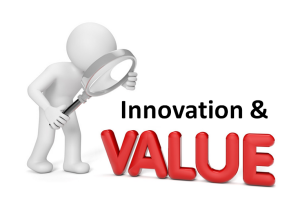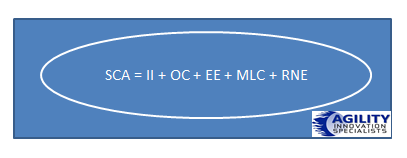 Innovation needs to create value, both short-term and progressively over time. It fuels the growth and fires the imagination.
Innovation needs to create value, both short-term and progressively over time. It fuels the growth and fires the imagination.
Yet our innovation activities are constantly coming up short for the leaders within our organizations, who continue to remain disappointed in its final outcome to stimulate and drive the growth they want to see.
It is actually the classic “chicken and egg”. Aristotle (384–322 BC) was puzzled by the idea that there could be a first bird or egg and concluded that both the bird and egg must have always existed. Leaders need to lead and are they the chicken, they are the resource for how can the people charged with innovation can lay the ‘golden eggs’ needed, if they are incapable of laying? Or should the innovation egg come first for our leaders to become more confident and build further, believing in innovation far more?
There should be no dilemma we can’t treat innovation lightly anymore, it needs to develop its uniqueness for each of our organizations to evolve. We need both the egg and the chicken to be ‘producing’.
What I’m driving towards here is that innovation is evolving is my 1st point
the integrated innovation framework
Building an innovation framework that has real capabilities as its formula as its heart.
 I’ve strongly believed when you begin to think through a framework for innovation, see my last article as an example, you also should equally need to recognize the capability framework that you will need to build into this.
I’ve strongly believed when you begin to think through a framework for innovation, see my last article as an example, you also should equally need to recognize the capability framework that you will need to build into this.
Working through these as essential combinations can become the real enabler.
Here is my solution that I think is worth working through, to firstly absorb and then consider for applying to your own innovation building activity. Try it!
I have worked on a formula SCA = II + OC + EE + MLC + RNE for this. I have never published the make-up of this in the public domain before, although I had briefly outlined it in a past post here.
In that post I outlined my thinking and I do not think it needs repeating, does it? So onward…….
Are we moving towards integrated software for innovation management?
 What is striking me recently is the upsurge in the software being specifically designed for managing innovation within our organizations.
What is striking me recently is the upsurge in the software being specifically designed for managing innovation within our organizations.
The competition seems to be warming up in the more ‘standalone’ out-of-the-box segment and the innovative tools being provided are certainly accelerating the innovation process.
The software being provided is going well beyond the simply mining and capturing of promising ideas. The solutions are moving into sound idea enrichment, evaluation processes and managing a portfolio of innovation in more holistic ways.
The providers here, namely Hype, Brightidea, Spigit, Imaginatik and a growing group of others have been significantly improving their ‘front end’ offerings to capture and develop concepts
They are increasingly turning their attentions to the ‘back end’ and support with a greater focus on governance, knowledge repositories, campaign cockpits, evaluation and dialogue exchange mechanisms. Mobility has also been a growing feature to capture innovation ‘on the go’.
Measuring and motivating the innovation elephant
 I often think of the parable of “The Elephant and the Blind Men” when I get into discussions about measuring innovation.
I often think of the parable of “The Elephant and the Blind Men” when I get into discussions about measuring innovation.
What are truths, what are the fallacies? The parable implies that one’s often subjective experience can be true on your need, but not necessarily the other person’s view of their understanding of value.
You get, as the end result, a failure to account for other ‘beliefs’ or capture the real value and miss providing broader motivations to encourage the innovation elephant along.
Establishing the right metrics that motivate and yield the result you are looking for is sometimes a tough challenge. You should always start with the bigger picture, organizational needs and then design the metrics and cascade these throughout the organization.
Developing talent to drive innovation
 I recently participated in a survey for APQC that was looking to identify the hot topics within product development and innovation. One or two hot spots surprised me, others less so.
I recently participated in a survey for APQC that was looking to identify the hot topics within product development and innovation. One or two hot spots surprised me, others less so.
In the round-up of results almost two-thirds of survey respondents have placed refining the identification of customer needs and remaining competitive in terms of profit at the top of their product development agendas. I like the increasing emphasis on identifying customer needs
Among the potential research areas respondents were asked about, they felt that developing talent to drive innovation was the most important. The second one was around rapid product development: How to Move Products to Market Faster.
The one that really caught my eye was organizations have allocated the most funds to improvement in developing talent to drive innovation. This is heartening but also a worry.
Innovation requires the nesting of all capital
 Innovation cannot exist without all the capitals that contribute to its make-up. Yet we simply fail to appreciate all the capitals that innovation requires. It is a real pity as they are truly nested.
Innovation cannot exist without all the capitals that contribute to its make-up. Yet we simply fail to appreciate all the capitals that innovation requires. It is a real pity as they are truly nested.
Equally many innovators are simply not prepared to put in the necessary work to achieve this understanding and the organization’s innovation looses out, stuck in perpetual incremental mode, lacking in anything really new or radical.
All the capitals ‘fire’ innovation. They make innovation combustible.
More often than not when we talk within business of capital we tend to default to the financial kind. Of course providing the financial capital into innovation is vital; it provides the potential ‘burn’ but what is often understated and certainly under-appreciated is the other capitals. These have been ‘tagged’ under intellectual capital or are often ‘lumped’ into our intangible assets.
What we need is to recognize the real “nesting effect” all our capitals.
Alignment is needed everywhere

Working in most organizations you spend a disproportional amount of time on looking to achieve alignment. This can range from aligning your meeting schedules to the bigger strategic issues by gaining agreement on the way forward.
I would bet you that working on alignment is certainly one of the main tasks that is sucking up a large part of your working day. Interesting enough the higher up in the organization you go, the more you have to seek alignment. Gaining alignment is actually very hard.
In corporate life we are constantly attempting to also link organizational goals with our own personal goals. To make this alignment, it requires the difficult aspect of achieving common understanding of all the parties for the specific purpose you are requiring, so as to achieve a consistency between ‘agreed’ objectives and the implementation of these across those involved.
In pursuit of alignment
Leaders need to engage and drive innovation
It continues to amaze me; actually it is depressing that although our business leaders constantly confirm that innovation is in their top three priorities yet they stay stubbornly disengaged in facilitating this across their organizations, especially the larger ones.
Of course I am not suggesting this is all our business leaders but I would argue innovation and its ‘make up’ remains a mystery to nearly all our leaders.
They are more than willing to allocate responsibility down the organization, failing to recognize their pivotal role in managing or orchestrating innovation engagement themselves, or even ensuring the mechanisms are fully in place. Why is this?
Time and time again you read one report after another, about the leadership gap in innovation or issues relating to innovation disconnecting from the top of the organization.
You can read reports from Booz, Allen Hamilton, Boston Consulting, the Conference Board, Harvard Business Review, IBM, A T Kearney, A D Little and many others all reporting issues and gaps in connecting innovation at the top of our organizations.
Can they all be wrong, if not then why aren’t our CEO’s listening? Why are we not resolving this and only just keep reporting it?
In March of this year Capgemini Consulting and IESE issued their report called the “Innovation leadership study” and this went deeper than most into the problems.